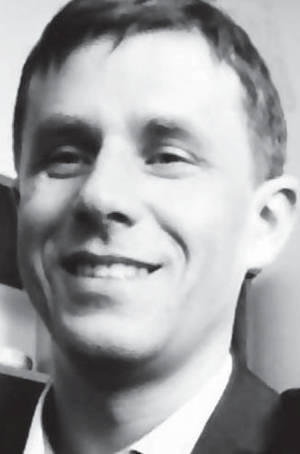Kinematic structure of elements of sports technique of «double back somersault tucked and layout» acrobatic exercises
Фотографии:
ˑ:
Tasks. 1. To make biomechanical measurements of double back salto tucked after round-off, and double back salto piked after round-off – flick-flack; to reveal the key elements of sports technique in the phase structure of exercises.
2. To study the kinematic structure of the indices of key elements of sports techniques of double back salto piked after round-off and double back salto piked after round-off – flick-flack.
Materials and methods. 1. Video registration of acrobatic exercises (control tests): double back salto tucked after round-off (variant I) and double back salto piked after round-off – flick-flack (variant II) using two digital video cameras, JVS 6R-DVL 9800 NTSC at the video recording speed of 240 frames per second. Measurement error was 3 % [4, 13]. Top level acrobats – track jumpers (n=7) were the subjects of the studies. Their height, weight and age mean values (х±δ) were as follows: 170.00±4.00 cm; 72.40±3.60 kg; 20.40±1,70 years.
2. The APAS 2000 (Ariel Dynamics Inc.) software applied to analyze articular angles of athlete’s motions when doing a double back salto tucked after round-off and a double back salto piked after round-off – flick-flack to meet the challenge of stable landing; velocities and accelerations of ankle, knee, hip, shoulder and wrist joints and the total body center of mass (TBCM); as well as analyzing body postures and positions on the support and in a support-free environment; duration of exercise phases; limb movements are symmetrical.
Results and discussion. The biomechanical analysis of the acrobatic exercises double back salto tucked after round-off and double back salto piked after round-off – flick-flack, resulted in establishing and studying the motion phase structure, and allocating the key elements of sports technique as the signal points (positions) of motions. The motion phase structure in the studied test tasks was considered as a structural-functional integrity, cause-and-effect relationships in performance of acrobatic jumps. The kinematic structure and the displacement vector of the total body center of mass (TBCM) during double back salto tucked after round-off (subject A, variant I), and double back salto piked after round-off – flick-flack (subject B, variant II) are shown on Fig.1. Both of the acrobatic jumps ended in stable landing.
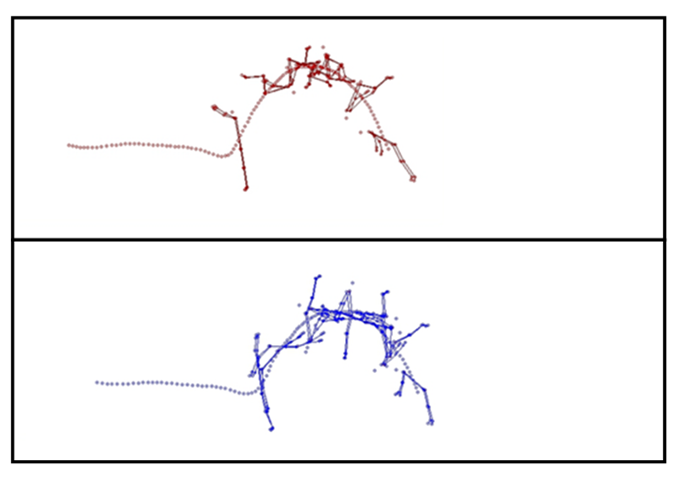
Fig. 1. Kinematic structure and trajectory of athlete’s total body center of mass (TBCM) displacement during double back salto tucked after round-off (subject A, top, variant I) and double back salto piked after round-off – flick-flack (subject B, bottom, variant II). Both of the acrobatic jumps ended in stable landing.
Phase structure of the study acrobatic exercises. The key technical element of the launching body position (LP), allocated in the phase of preparatory motor actions in the two types of salto under examination, represents the biomechanically expedient position of acrobat’s body on support in the system of coordinates, creating effective conditions for take-off and upward-backward, whereas in the phase of major motor actions – multiplication of positions (MP) of an athlete’s body is the key element of the sports technique. Multiplication of positions of an athlete’s body implies the process of successive alternation of instant fixed positions to create an integral motor action, determining and characterizing the structure of exercise; the key element of sports technique in the final phase is the concluding body position (CP) – landing (to stop or transition).
The key element of the sports technique – the body launching position - was recorded at the end of concluding motor actions of the round-off, preceding a double back salto tucked (subject A, top, variant I, time 0,633 s), and a flick-flack, preceding a double back salto piked (subject B, bottom, variant II, time 0,583 s) (Fig.2). Indices of the biomechanical analysis of performed exercises (double salto) show both the identity of launching body positions and the difference in them.

Fig. 2. Phase of preparatory motor actions. Key element of sports techniques – launching position of athletes’ body performing a double back salto tucked after round-off (subject А, variant I, time 0.633s) and a double back salto piked after round-off – flick-flack (subject B, variant II, time 0.583s)
The indices of articular joints characterize the launching body positions of executed double salto are as follows: the hip-trunk angle is equal to 177.0° and 184.4° for the subjects A (variant I) and B (variant II) respectively. In the variant I the athlete maintains the body position rigidly, actively interacts with the support and efficiently puts elastic energy into action. It is confirmed by the scientific fact that velocity curves (resultant) of the body biolinks of the athlete A are “bunched”, when holding the launching body position on the support for a short time (Fig. 3, time 0.633 s).
In the variant II the athlete B allows excessive plasticity of the body position during the short-term fixation of the body LP on the support with hands up and slightly backward. This contributes to body arching (the hip-trunk angle is equal to 184,4°). We assume that a certain loss of energy concentration have occurred during the short-term holding of the body LP on the support together with the weakened “athlete – track” system and, consequently, the resultant velocities of body biolinks failed to be “bunched” (Fig. 3, 0,583 s). As long as exercises were performed by elite acrobats, then the revealed peculiarities of executing launching positions should be explained by the individual technical style and are considered with the potential of further improvement of motor skills of executing the key element of sports technique - the body launching position (variant II).

Fig. 3. Trajectories of resultant velocities of displacement of ankle, knee, hip, shoulder, elbow and wrist joints and TBCM at short-term holding of the body launching position during double back salto tucked after round-off (subject A, top, variant I) and double back salto piked after round-off – flick-flack (subject B, bottom, variant II).
NOTE: TBCM = total body centre of mass.
The resultant velocities of vertical and horizontal constituents of the body biolinks and TBCM when performing a double back salto tucked (variant I) and a double back salto piked (variant II) with stable landing while taking the body LP were differentiated. In variant I the velocity of movement of ankle, knee, hip, shoulder, elbow and wrist joints within 0.633 seconds amounted to 4.041, 5.140, 5.999, 8.080, 7.724 and 8.170 m/s, respectively, whereas that in the variant II within 0.583 seconds – 3.001, 4.096, 5.084, 8.176, 12.893 and 17.852 m/s, respectively. The total body center of mass (TBCM) was displaced in the variant I within 0.633 s with the velocity of 6.296 m/s, whereas that in the variant II within 0.583 s – with the velocity equal to 5.937 m/s. Such a differentiation of velocities (especially that of wrist joints – variant I – 8,170 m/s; variant II – 17,852 m/s) can be due to the fact that in the variant I the athlete A arranges body biolinks (with hands forward and up) over the support more efficiently in respect to biomechanics, thus trying to make the ballistic wave of the impulse of force (momentum) of the system being in elastically rigid state coincide with the support counteraction to elastically rigid state of athlete body. The above allows the acrobat to perform high upward-backward jump and more then ¾ turn in the first salto on the ascending segment of flight trajectory. In variant II in order to achieve greater plasticity and dynamics of the launching position, athlete B executes an excessive upward-backward hand swing while keeping on the support for fly up to the first salto of double somersault, thus losing the required rigidity of the system. It results, to a certain extent, in dyscoordination of the ballistic wave of the impulse of force and insufficiently controlled body arching in lumbar spine while entering the main phase of double back salto piked.
Phase of major motor actions. The key element of sports techniques – multiplication of position (MP) of the body “tuck position” (subject A, variant I, in the time period of 0.883 s) and multiplication of position (MP) of the body “stretch position” (subject B, variant II, in the time period of 0.716 s). The hip-trunk angle is equal to 76.5° and 223.6° in variant I and II, respectively (Fig. 4).
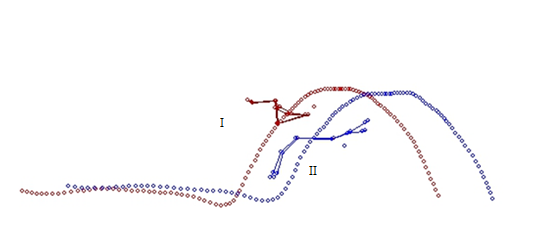
Fig. 4. Phase of major motor actions. Key element of sports techniques - MP of the body “tucked position” (subject А, variant I in the time period of 0.883 s) and MP of the body “piked position” (subject B, variant II in the time period of 0.716 s).
Fig. 5 presents trajectories of the resultant velocities of the displacement of ankle, knee, hip, shoulder, elbow and wrist joints and the total body center of mass (TBCM) in the phase of major motor actions – MP of the body during the double back salto tucked performance, executed after the round-off (subject A, top, variant I, in the time period of 0.833 s) and the double back salto piked performance, executed after the round-off – flick-flack (subject B, bottom, variant II in the time period of 0.716 s). They reveal causative-consecutive dependences of the energy transfer of preceding motions (positions) to subsequent ones. Increased velocities of ankle and knee joint motion were recorded on the ascending segment of flight trajectory, which activate motor actions – rotation around transverse axis.

Fig. 5. Trajectories of the resultant velocities of the displacement of ankle, knee, hip, shoulder, elbow and wrist joints and TBCM in the phase of major motor actions – MP of the body during the performance of double back salto tucked, executed after the round-off (subject A, top, variant I in the time period of 0.833 s) and double back salto piked, executed after the round-off – flick-flack (subject B, bottom, variant II in the time period of 0.716 s).
NOTES: TBCM = total body center of mass; MP = multiplication of position.
In variant I the velocity of motion in the time period from 0.633 s to 0.883 s increased in ankle, knee, hip and shoulder joints by 7.285 m/s, by 3.026 m/s, by 1.305 m/s and by 5.674 m/s, respectively, and decreased by 5.873 m/s and by 2.870 m/s in elbow and wrist joints, whereas in variant II (0.583 s – 0.717 s) it increased in ankle, knee and hip joints by 11.162 m/s, by 4.818 m/s and by 0.893 m/s, respectively, and decreased by 2.773 m/s, by 7.544 m/s and by 12.860 m/s in shoulder, elbow and wrist joints, respectively. The total body center of mass was displaced with the velocity of 2.388 m/s and 0.846 m/s in variant I and variant II, respectively.
During the subsequent part of MP of the body the athletes perform the first salto on the ascending segment of flight trajectory within the structure of double salto (variant I, time period of 1.033 s, hip-trunk angle is equal to 69.30°; variant II, time period of 0.917 s, hip-trunk angle is equal to 151.30°), (Fig. 6).
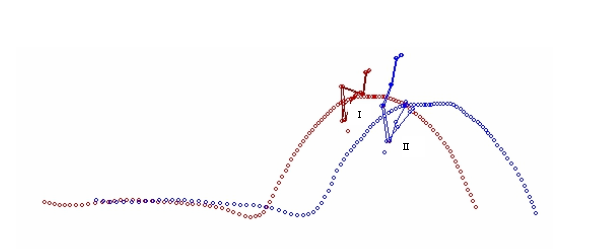
Fig. 6. Phase of major motor actions of acrobats performing the first salto on the ascending segment of flight trajectory within the structure of double salto. Key element of sports techniques – MP of the body “tucked position” (subject А, variant I in the time period of 1.033 s) and MP of the body “piked position” (subject B, variant II in the time period of 0.917 s)
In variant I acrobat A assumes tight tuck position, whereas in variant II acrobat B assumes slightly bent body position to maintain speed of rotation in order to prepare for the execution of unceasing “entrance” in the second salto within the structure of double salto (Fig. 7).

Fig. 7. Trajectories of the resultant velocities of displacement of ankle, knee, hip, shoulder, elbow and wrist joints and TBCM in the phase of major motor actions – MP of the body during the performance of double back salto tucked after round-off (subject A, top, variant I in the time period of 1.033 s) and double back salto piked after round-off – flick-flack (subject B, bottom, variant II in the time period of 0.917 s).
As shown in Fig. 8 in variant I in the time period of 1.033 s the velocity of motion of ankle, knee, hip, shoulder, elbow and wrist joints amounted to 8.224 m/s, 4.136 m/s, 5.882 m/s, 2.145 m/s, 3.240 m/s and 4.326 m/s, respectively, whereas in variant II in the time period of 0.917 s the following indices were noted: 14.529 m/s, 9.537 m/s, 5.184 m/s, 3.606 m/s, 2.672 m/s, 2.998 m/s, respectively. Velocity of the total body center of mass amounted to 3.313 m/s and 4.082 m/s in variant I (in the time period of 1.033 s) and variant II (in the time period of 0.917 m/s), respectively.
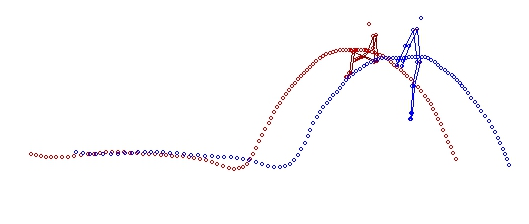
Fig. 8. Phase of major motor actions during “entrance” of acrobats in the second salto while performing double back salto tucked after round-off and double back salto piked after round-off – flick-flack. Key element of sports techniques – MP of the body “tuck position” (subject А, variant I in the time period of 1.266 s) and MP of the body “stretch position” (subject B, variant II in the time period of 1.183 s).
In variant I (in the time period of 1.266 s) the velocity of motion of ankle, knee, hip, shoulder, elbow and wrist joints constituted 4.105 m/s, 4.099 m/s, 2.442 m/s, 6.286 m/s, 3.344 m/s and 1.755 m/s, respectively, whereas in variant II (in the time period of 1.183 s) the following indices were noted: 7.297 m/s, 2.858 m/s, 1.898 m/s, 8.082 m/s, 5.400 m/s and 3.338 m/s, respectively. The total body center of mass in variant I and variant II constituted 2,748 m/s and 3,002 m/s, respectively. In variant II velocities of ankle and shoulder joints tended to prevail, thus confirming active motor actions of acrobat B during “entrance” in the second salto (Fig. 9).

Fig. 9. Trajectories of the resultant velocities of the displacement of ankle, knee, hip, shoulder, elbow and wrist joints and TBCM in the phase of major motor actions – MP of the body (“entrance” in the second salto) during the performance of double back salto tucked after round-off (subject A, top, variant I, in the time period of 1.266 s) and double back salto piked after round-off – flick-flack (subject B, bottom, variant II in the time period of 1.183 s).
NOTES: TBCM = total body center of mass; MP = multiplication of positions.
Phase of concluding motor actions. Athletes A and B in variants: I (in the time period of 1.533 s) and II (in the time period of 1.516 s) realize motor preparation for the execution of the key element – concluding body position (CP) – landing. Preparation of athletes for landing is characterized by articular angles (hip-trunk angle is equal to 100.15° and 145.79°, in variant I and II, respectively) (Fig. 10) as well as presented in Fig. 11 trajectories of the resultant velocities of the displacement of ankle, knee, hip, shoulder, elbow and wrist joints and TBCM of athletes in the phase of concluding motor actions during the performance of double back salto tucked after round-off (subject A, top, variant I in the time period of 1.533 s) and double back salto piked after round-off – flick-flack (subject B, bottom, variant II in the time period of 1.516 s).
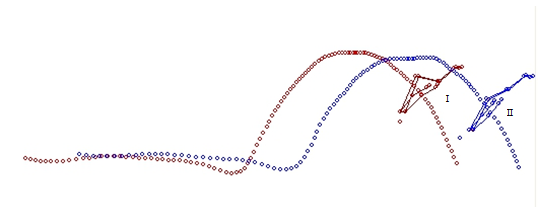
Fig. 10. Phase of concluding motor actions when doing double back salto tucked after round-off (subject А, variant I in the time period of 1.533 s) and double back salto piked after round-off – flick-flack (subject B, variant II in the time period of 1.516 s). Athletes prepare for the execution of stable landing.

Fig. 11. Trajectories of the resultant velocities of the displacement of ankle, knee, hip, shoulder, elbow and wrist joints and TBCM in the phase of concluding motor actions – (CP) of the body when doing double back salto tucked after round-off (subject A, top, variant I in the time period of 1.533 s) and double back salto piked after round-off – flick-flack (subject B, bottom, variant II in the time period of 1.516 s).
NOTES: TBCM = total body center of mass; CP = concluding position.
In variant I in the time period of 1.533 s the velocity of motion of ankle, knee, hip, shoulder, elbow and wrist joints constituted 12.762 m/s, 7.086 m/s, 6.347 m/s, 1.654 m/s, 4.489 m/s and 5.608 m/s, respectively, whereas that in variant II (1.516 s) – 16.828 m/s, 10.746 m/s, 5.749 m/s, 1.397 m/s, 4.693 m/s and 7.997 m/s, respectively. Velocity of total body center of mass constituted 4.994 m/s and 5.336 m/s in variant I and II, respectively (Fig.12).
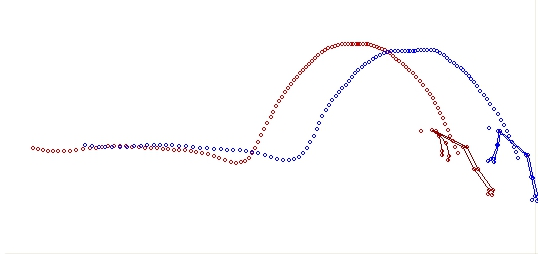
Fig. 12. Phase of concluding motor actions when doing double back salto tucked after round-off (subject А, variant I in the time period of 1.750 s) and double back salto piked after round-off – flick-flack (subject B, variant II in the time period of 1.683 s). Body positions on the support precede the key element of sports techniques – CP, i.e., position of stable landing (half-squat position with forward half bent, hands forward-downward).
Video analysis and pedagogical observations allow us to conclude that in variant I and II elastically rigid interaction of acrobats and the support was observed contributing to the assumption of optimum CP – half-squat position with forward half bent, hands forward-downward and efficient body position regulation on the support {1,10,12,13}.
The resultant velocities of the body biolinks and TBCM serve as evidence of efficient motor actions on the support. They “bunched” during the time period of 1.750 s and 1.683 s in variant I and II, respectively (Fig. 13). The only exception to the rule was the velocity of elbow joints (1.854 m/s, variant II).

Fig. 13. Trajectories of the resultant velocities of the displacement of ankle, knee, hip, shoulder, elbow and wrist joints and the TBCM in the phase of concluding motor actions – (CP) of the body when doing double back salto tucked after round-off (subject A, top, variant I in the time period of 1.750 s) and double back salto piked after round-off – flick-flack (subject B, bottom, variant II in the time period of 1.683 s).
NOTES: TBCM = total body center of mass; CP =concluding position.
In variant I in the time period of 1.750 s the velocity of motion of ankle, knee, hip, shoulder, elbow and wrist joints constituted 7.270 m/s, 7.226 m/s, 6.648 m/s, 4.926 m/s, 5.103 m/s and 4.735 m/s, respectively, whereas that in variant II (1.683 s) – 5.620 m/s, 6.908 m/s, 7.293 m/s, 5.837 m/s, 1.854 m/s and 5.656 m/s, respectively. Velocity of TBCM constituted 5.811 m/s and 5.305 m/s in variant I and II, respectively.
Conclusions.
1. In the phase structure of track acrobatic exercises “double back salto tucked” after round-off and “double back salto piked” after round-off – flick-flack, key elements of sports techniques were revealed by means of postural orienting points of motions. It was discovered that the key element of sports techniques is represented by signal point (position) of motion, predetermining subsequent efficient motor actions. It was proved that signal points (positions) of studied acrobatic jumping exercises are: launching body position (biomechanically rational body positions on the support for efficient upward fly up to salto), multiplication of body positions (successive alternation of instant fixed positions to make an integral motor action), concluding body position (landing to stop or transition).
2. The kinematic structure of key elements of sports technique of “double back salto tucked” after round-off and “double back salto piked” after round-off – flick-flack, studied using the APAS 2000 (Ariel Dynamics Inc.) software, is characterized by individual indices of executing launching body position, multiplication of body positions, concluding body position: articular angles of athletes’ motions, velocities of ankle, knee, hip, shoulder, elbow and wrist joints and TBCM; body positions and positions on the support and in support-free environment; time of exercise phase execution.
- Boloban V.N. The system of movements training in difficult conditions of maintaining the static-dynamic stability / V. N. Boloban // Dissertation doctor. ped. sciences. – Kiev: KGIFK, 1990. – 45p
- Boloban V.N. Long-Term Training Program of Sports Acrobatics Exercises / V. Boloban // Science in Olympic Sports. - Kiev: UNPTSU, 2011. – N 1-2. – P. 75–87.
- Romanov N.S. Pose method of teaching technique of athletics run and jumps / N.S. Romanov, A.I. Pyanzin, E.V. Nikitina // Theory and Practice of Physical Culture, 2011. – № 4. – P. 73–77
- Sadowski J. Components of the structure of acrobats’ technical preparation / J. Sadowski, V. Boloban, A. Mastalerz, T. Niźnikowski // Theory Practice of Physical Culture, 2003. – № 9. – P. 19–23
- Sadowski J. Motion pose cues as method of analysis and estimation of indices of kinematic structure of nodal elements of sports technique of basic series of exercises “handspring pike open front somersault” / J. Sadowski, V. Boloban, T. Niźnikowski, A. Mastalerz, T. Niźnikowski, W. Wisniowski, M. Bigailo // Theory and Practice of Physical Culture, 2012. – N 7. – P. 98–102.
- Boloban V. Didactic technology in mastering complex motortasks / V. Boloban, J. Sadowski, T. Niźnikowski, W. Wiśniowski // Coordination motor abilities in scientific research. Edited by: J. Sadowski, T. Niźnikowski. – Biała Podlaska: Faculty of Physical Education and Sport, 2010. – Vol. 33. – P. 112–129
- King M.A. Coping with perturbations to a layout somersault in tumbling / M. A. King, M.R. Yeadon // Journal of Biomechanics, 2003, 36(7):921-7.
- Niźnikowski T. Nauczanie ćwiczeń o złoźonej strukturze ruchu przy oddziaływaniu na węzłowe elementy techniki sportowej / T.Niźnikowski // Biała Podlaska: ZWWF, 2009. – 148 s.
- Sadowski J. Velocities and joint angles during double backward stretched salto performed with stable landing and in combination with tempo salto / J. Sadowski, V. Boloban, A. Mastalerz, T. Niźnikowski // Biology of Sport, 2009. – Vol. 26. – P. 87–101.
- Niźnikowski T. Biomechanical criterions to estimate round-off tucked performance among acrobats aged 10-11 / T. Niźnikowski, J. Sadowski, A. Mastalerz, W. Wiśniowski, D. Kruczkowski, E. Niźnikowska, M. Biegajło, J. Miller. // Pol. J. Sport Tourism 2011, 18, 296–299.
J. Sadowski
Ph.home: +48833428825, ph.official: +48833428803
W. Boloban
Ph.home: +48833428836, ph.official: +48833428761
T. Niznikowski
Ph.home: +48 507149990, ph.mob.: +48833428759
A. Mastalerz
Ph.home: +48 227599483, ph.mob.: +48 228342713
W. Wisniowski
ph.official: +48833428756, ph.mob.: 661 64 05 71
M. Buszta
ph.mob.: +48 698 688 089

